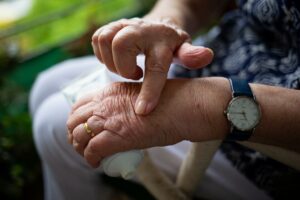 Image by PeachMoon from Pixabay
Image by PeachMoon from Pixabay
A shocking revelation tells us that in India alone, more than ten million people suffer from Arthritis. Naturally, there is a protracted interest in the causes, diagnosis, and management of this extremely painful condition.
As an overview, arthritis can be best described as an inflammatory condition that intensifies with age. It disturbs the quality of life and is nagging and disabling to a point. Hence the use of appropriate medication, physiotherapy, and even sometimes surgery may help in the reduction of symptoms.
In the immediate presentation in the body, one or more joints become inflamed leading to pain and a distinct difficulty in movement. Sometimes, two or more bones may even move in close proximity to one another. Arthritis as a disease may present itself as osteoarthritis(OA), gout, fibromyalgia, and rheumatoid arthritis (RA).
The general causative factors of arthritis are many. Genetic factors are significant since some forms of arthritis may run in families and automatically put the subject in a high risk group.
The likelihood that one may acquire arthritis increases as one ages, however, arthritis can strike at any age, even young adulthood. Interestingly, OA and RA are two forms of arthritis that affect women more frequently than male subjects. If one has ever suffered a serious injury to a joint, there is a larger risk of developing OA later in life. Interestingly, carrying too much weight can strain your joints and increase your risk of getting arthritis.
The prominent symptoms of arthritis include, aching or pain at the joint or in the area that often gets worse over the day. Restricted movement of the affected area and a distinct redness and swelling. In contrast to OA symptoms, which are more susceptible to problems over time, RA symptoms typically appear suddenly. While OA symptoms may worsen the condition of joints on one side of the body compared to the other, RA symptoms often affect both sides of the body.
Diagnostic strategies are many and are significant in treatment and study of Arthritis.
- X-ray. In some cases of arthritis, X-rays can reveal changes to the joints and bone deterioration. You might also perform additional imaging testing.
- To examine the condition of synovial tissue, tendons, ligaments, and bones, ultrasound employs sound waves rather than radiation.
- Magnetic resonance imaging (MRI). X-rays lack the fine detail of MRI pictures. They could reveal cartilage, ligaments, and muscle degeneration in the joints.
- To view the inside of the joint during this surgery, a thin tube (arthroscope) with a light and camera is used. A tiny incision is used to insert the arthroscope into the joint. A screen is projected with images of the joints inside. It is used to assess any arthritic or degenerative changes in the joint.
Osteoarthritis (OA)
OA is the most common type of arthritis which affects middle aged or older people most frequently. It is caused by breakdown of cartilage in joints and can occur in almost any joint of the body, most commonly affects the hip, knees, hands, lower back and neck.
Causes
Several factors that can increase the risk of a person developing osteoarthritis(OA):
- Age – main causes of joint damage, leading to OA.
- Obesity- increases the risk of OA in the knee, hip and spine.
- Heredity – having family with the condition.
- Joint injury
- Nerve injury
- Overuse of joints
- Lack of physical activity
- Poor posture
- Past injury such as torn cartilage, dislocated joints or ligament injuries
- Menopause
- Occupation – having an occupation involving kneeling, climbing, heavy lifting and a strenuous routine.
- Gender – women have higher rates of OA than male subjects.
- Other diseases –such RA
Symptoms
Most common symptoms of OA include:
- Joint pain
- Stiffness in the joint
- Loss of flexibility and reduced range of motion
- Tenderness/ discomfort when pressing on the affected areas with your fingers
- Inflammation
- Pain and stiffness in the lower back and neck
- Weakness or numbness in both arms
- Pain that worsens throughout the day due to activity
- Joint swelling
- Bone enlargement in middle and end joints of the fingers (may or may not be painful)
Diagnosis
Osteoarthritis is a disease which develops gradually. A diagnosis can be made based on:
- Specific symptoms
- Location and pattern of pain
- A thorough physical examination
- X- Rays – this helps to confirm the diagnosis and make sure the type of arthritis is confirmed. The extent of joint damage is also confirmed through X-ray scans.
- MRI (Magnetic Resonance Imaging) – may be necessary to get a better look at the joints and surrounding tissues. MRI uses radio waves and magnetic field to create images of bone and soft tissue. An MRI can reveal damages cartilage, loss of joint space or bone spurs.
Other diagnostic tests:
- Blood tests – performed to determine if one has a different type of arthritis such as Rheumatoid arthritis (RA).
- Synovial Joint Fluid analysis – also help to determine whether gout or infection is the underlying cause of the inflammation.
Rheumatoid arthritis(RA)
Rheumatoid arthritis (RA) is a chronic inflammatory disorder not only directed at the joint but at many other parts of the body too. In this disorder, the body’s immune system starts to attack body tissues and most damage occurs to joint lining and cartilage.
RA is the result of immune response but specific causes are unknown. Some factors can increase the risk of RA like age, genetic/ inherited traits, obesity etc.
RA is typically triggered by an interaction between genetic and environmental factors such as a person with a specific gene human leukocyte antigen (HLA) or HLA-DR1, HLA-DR4 might develop RA after getting exposed to environments like cigarette smoke or specific pathogens like bacteria. This interaction causes the modification of antigens.
Signs and symptoms of RA are chronic, long-lasting, occur throughout life and have an insidious onset. RA affects most commonly small joints of hands and feet as the disease worsens it affects large joints like knees, hips, shoulders and neck. Soft tissue swelling and symmetrical distribution of affected joints i.e. pain that occurs at the same joint on both sides of the body are the earliest signs of RA.
Initial symptoms are fatigue, feeling very tired and low energy, fever and heavy sweating at night, weight loss, muscle aches and pain, tender muscle and sleep disturbance. Other symptoms are rheumatoid nodules commonly affecting elbows, heels and toes, inflammation of the sclera and episclera of the eyes. Some systemic symptoms of RA are inflammation of the pericardium around the heart, myocarditis, fibrosis of the lung, bronchitis, xerophthalmia, xerostomia, and skin issues that can occur like palpable purpura, ulceration. RA shows specific deformities like ulnar deviation of fingers, swan neck deformities, claw toe deformities, subluxation of metatarsal heads etc.
Diagnosis usually involves blood tests to check levels of CRP (C- reactive protein) that increase when there is inflammation. Blood tests like rheumatoid factor and anti-CCP antibodies test help to confirm the diagnosis of rheumatoid arthritis. Imaging studies like x-ray and MRA scans can detect bone density, bone erosion, soft tissue.
Dietary and lifestyle interventions in Arthritis
The concept of a holistic approach to alleviation and management is most important. This involves dietary and lifestyle interventions.
Mediterranean Diet: The Mediterranean diet is rich in oleic acid, omega-3 fatty acids, unrefined carbohydrates, and phytochemicals. This involves consumption of olive oil, cereals, fruits, vegetables, fish, & legumes; less red meat in the diet. Olive oil which is an important content of the MD diet has antioxidant properties, is rich in oleic acid, and has anti-inflammatory effects. The intake of olive oil in the diet decreases the risk of developing arthritis and the inflammation was reduced and vitality & physical functions were improved. This diet can help to reduce weight, which can lessen joint pain.
Seven Days Fasting Followed by Vegan Diet: Fasting of 7-10 days with the limited nutrient intake of garlic, vegetable broth, herbal teas, parsley; juice of carrots, beets, and celery followed by one year of vegan diet showed a notable decrease in swollen and tender joints and pain.
A diet including intake of only fruits and vegetables is a vegan diet. It has shown beneficial effect with the people with arthritis. A vegan diet can potentially reduce symptoms and disease activity in arthritis patients.
Omega-3 fats and arthritis :Foods that contain omega-3 fats have been found to help reduce the inflammation associated with some forms of arthritis. Some of the Omega-3 fat rich foods includes, salmon & sardine, flaxseed oil, rapeseed oil, walnuts and fish oil supplements. Consumption of food rich in omega-3 fats helps reduce joint swelling and pain, morning stiffness and disease activity.
Fruits & Vegetables: These are loaded with antioxidants and act as the body’s natural defense system, by neutralizing free radicals. Anthocyanins found in cherries & berries have an anti-inflammatory effect. Citrus fruits like oranges, grapefruits and limes which are rich in vitamin C aids in preventing arthritis & maintaining healthy joints. Also vitamin K-rich veggies like broccoli, spinach, lettuce, kale and cabbage also reduces inflammation.
Lifestyle changes
Healthy diet: Fruits, vegetables and whole grains, salmon and tuna helps to fight painful swelling in joints. It can maintain a low body weight which can alleviate stress on joints.
Exercise: It helps to keep body weight in a healthy range, but only with the right exercise program which can keep joints functioning optimally.
Cut out bad habits: Smoking, drinking & junk food can damage the connective tissues and so this habits should be avoided.
Yoga and meditation: This combines stretching & balance exercises with psychological harmony, so it improves joint function and helps to elevate mood.
The author acknowledges the use of authentic medical literature to structure this article.
Sign up for the QuackTrack.org newsletter below!














